During endoscopic surgery, a surgeon’s hands and eyes must work in perfect harmony. Any delay in visual feedback can introduce uncertainty. I understand that absolute confidence in the real-time image is essential for patient safety.
Image lag, or latency, can severely compromise endoscopic surgery safety by creating a disconnect between a surgeon’s actions and the visual feedback they receive. This delay can lead to inaccurate movements, tissue damage, and critical surgical errors.
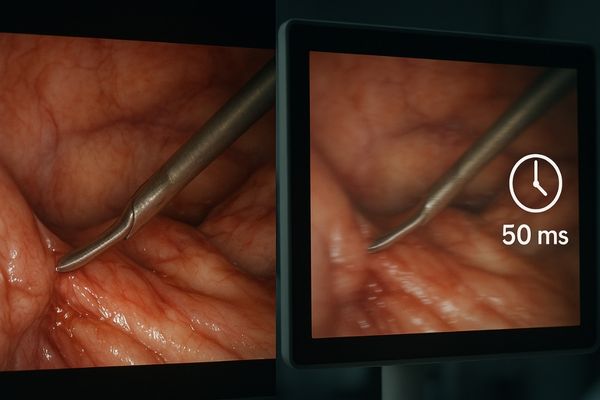
The shift to minimally invasive surgery1 has placed immense importance on the quality of video technology in the operating room. The monitor is the surgeon’s window into the patient’s body. A clear, accurate, and instantaneous image is not a luxury; it is a fundamental requirement. Image lag, the delay between an action happening at the surgical site and it appearing on the screen, is a subtle but dangerous threat. I will explore the causes of this lag and its direct impact on surgical performance. We will also discuss acceptable latency levels and how monitor technology2 can be optimized to virtually eliminate this risk, ensuring a safer surgical environment.
What causes image lag in surgical monitors during endoscopic procedures?
A surgeon performs a precise movement, but the image on the screen does not update instantly. This slight delay can feel disorienting. It raises questions about the reliability of the entire imaging chain.
Image lag in surgical monitors is primarily caused by processing delays within the video chain. This includes signal conversion, complex decoding of high-resolution video like 4K, insufficient interface bandwidth, and the monitor’s own internal processing and pixel response time.
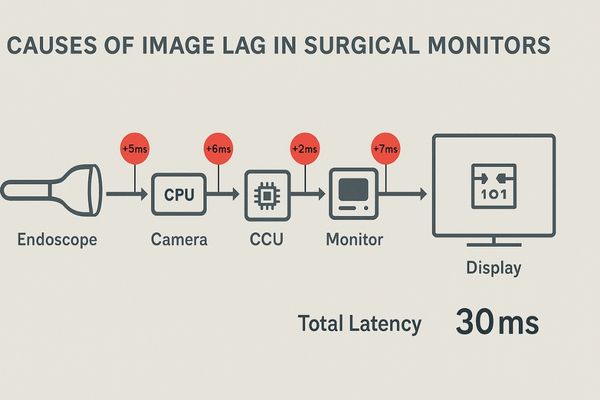
Image lag, technically known as latency, is the cumulative delay from the moment the camera captures an image to when it is displayed. Several factors contribute to this delay. The process begins at the endoscopic camera head, which captures and initially processes the image. The signal then travels to the camera control unit (CCU)3, where it is converted and encoded, often for transmission over long cables. Each of these steps adds a few milliseconds of delay. The signal then travels through a cable to the surgical monitor. The monitor itself is a significant source of potential latency. It must receive the signal, decode it if it is compressed, scale it to fit the panel’s native resolution, and perform any image enhancement processing. Finally, the liquid crystals in the display panel require a fraction of a second to physically change state to form the new image. When dealing with high-resolution 4K video4, the amount of data is immense, and the decoding and processing tasks become far more demanding, increasing the risk of lag. Our MS321PC – 32" 4K Surgical Monitor is designed with powerful processors to handle these data-intensive tasks efficiently and minimize latency.
Common Sources of Latency in the Surgical Video Chain
Latency is an accumulation of small delays. Understanding where these delays occur is the first step in minimizing them.
| Stage | Potential Causes of Lag |
|---|---|
| Image Capture | Sensor processing time in the endoscopic camera. |
| Signal Processing | Encoding/decoding, color correction, and format conversion in the CCU. |
| Transmission | Bandwidth limitations of the interface (e.g., HDMI 1.4 vs. 2.0). |
| Display | Internal monitor scaling, image enhancement algorithms, pixel response time. |
Addressing each of these stages is crucial for achieving an ultra-low-latency video stream.
How does even slight latency affect a surgeon’s motor coordination?
Surgeons develop an intuitive feel for their instruments, relying on instant visual confirmation. A small, almost imperceptible delay can break this connection. It can make precise movements feel clumsy and uncertain.
Even slight latency disrupts the brain’s natural hand-eye coordination feedback loop. This desynchronization forces the surgeon to slow down and make more deliberate, less fluid movements, which increases cognitive load and can lead to overcorrection or mistimed actions.

A surgeon’s ability to perform delicate tasks relies on a seamless connection between what their hands do and what their eyes see. This is a rapid feedback loop processed by the brain. When a surgeon moves an instrument, they expect to see the result of that movement instantly. Image lag introduces a delay into this loop. Even a delay as short as 100 milliseconds (one-tenth of a second) is perceptible and can have a significant impact. It creates a mismatch between the motor command sent to the hands and the sensory feedback received by the eyes. The brain tries to compensate for this lag, but this often leads to overshooting a target or making hesitant, jerky motions instead of smooth, confident ones. This effect is similar to the experience of a delayed video conference call, where the lag between speaking and hearing makes natural conversation difficult. In a surgical context, this disruption increases the surgeon’s cognitive load5, as they must consciously fight their own reflexes and predict where the instrument tip will be. This mental effort can lead to faster fatigue and a higher potential for error. Our MS270P – 27" FHD Surgical Display is engineered for minimal latency6 to ensure this critical feedback loop remains intact, allowing for natural and precise instrument control.
Can image lag increase the risk of tissue damage or surgical error?
In the high-stakes environment of the operating room, every movement counts. A delayed view of the surgical field can turn a precise action into a mistake. The consequences of such an error can be serious.
Yes, image lag directly increases the risk of inadvertent tissue damage and other surgical errors. The delay impairs a surgeon’s real-time judgment, potentially causing them to cut beyond a intended boundary, perforate a vessel, or damage a delicate nerve before the visual feedback confirms the error.
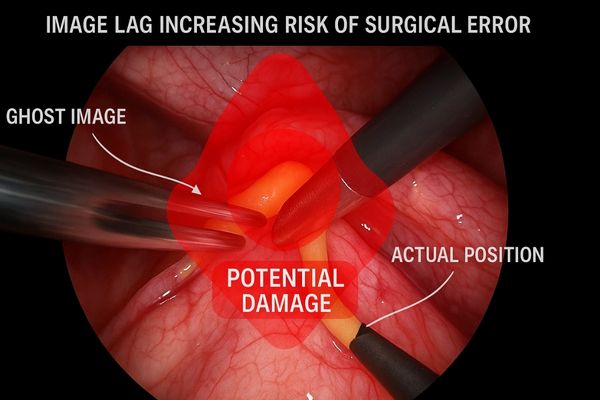
The link between image lag7 and surgical risk is direct and significant. In minimally invasive surgery8, the surgeon operates in a confined space, often near critical structures like major blood vessels and nerves. Their ability to safely dissect tissues or apply sutures depends entirely on the real-time visual information provided by the monitor. When latency is present, the image on the screen is a fraction of a second out of date. This means a surgeon might continue a cutting motion for a few extra milliseconds before their brain registers that the instrument has reached its target. In that brief moment, an instrument can travel far enough to cause irreversible damage. For example, when working near an artery, a delayed view could lead to a perforation, resulting in significant bleeding. Similarly, when dissecting around a nerve, a mistimed movement could cause permanent injury. The risk is magnified during dynamic tasks like controlling bleeding with cautery or suturing delicate tissues, where timing is everything. A lag can cause a surgeon to apply energy for too long or place a suture inaccurately. The MS321PB – 32" 4K Surgical Monitor is built to provide an immediate, clear image, giving surgeons the confidence to act decisively and safely, knowing that what they see is happening in that exact moment.
Potential Surgical Errors Caused by Latency
Image lag is not a minor inconvenience; it is a direct threat to patient safety. The table below outlines specific risks.
| Surgical Action | Risk Amplified by Image Lag | Consequence |
|---|---|---|
| Dissection | Cutting past the intended tissue plane. | Damage to adjacent organs or vessels. |
| Cauterization | Applying thermal energy for too long or in the wrong location. | Unintended burns, tissue necrosis. |
| Suturing | Inaccurate needle placement or pulling a suture too tight. | Poor wound closure, tissue tearing. |
| Navigation | Overshooting a target when maneuvering the endoscope. | Trauma to internal structures. |
Minimizing latency is therefore a critical component of risk management in the OR.
How much latency is acceptable in high-precision endoscopic surgery?
Perfection is the goal, but technology has limits. We need to define a threshold for latency that is safe for surgery. Knowing the acceptable number helps in evaluating and selecting the right equipment.
For high-precision endoscopic surgery, total latency should be kept below 50 milliseconds (ms). An ideal target for critical procedures is under 30ms. For advanced applications like 3D or image-guided surgery, the threshold for acceptable latency is even lower to ensure proper spatial perception.
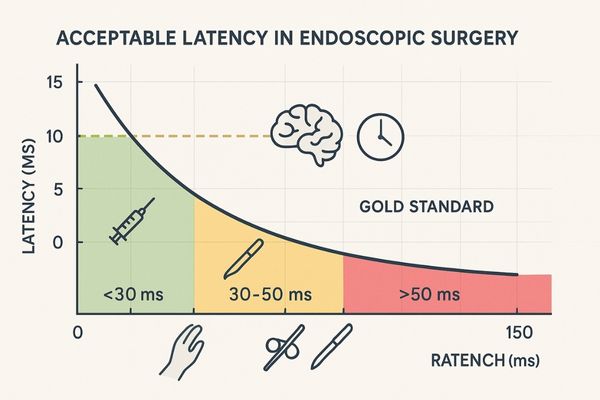
While zero latency is the theoretical ideal, it is not achievable in practice. Every component in the video chain introduces some small delay. The critical question is how much delay is functionally imperceptible and safe for a surgeon. Extensive research and clinical experience have established some important benchmarks. A total system latency9 of over 100ms is widely considered to be noticeable and can actively hinder performance. A latency between 50ms and 100ms may be acceptable for less demanding procedures but can still be problematic. For most high-precision endoscopic surgeries, the consensus is that the total "glass-to-glass" latency—from the camera lens to the display screen—should be under 50ms. To provide a truly real-time feel and ensure the highest level of safety and precision, a latency below 30ms is the gold standard that high-performance systems aim for. This threshold becomes even more critical in specialized procedures. For instance, in 3D endoscopy10, mismatched latency between the two eye channels can cause disorientation and headaches. In navigated or robotic surgery, where the surgeon’s actions are translated into robotic movements, minimizing lag is absolutely essential for safe and effective control. The MS192SA – 19" HD Endoscopic Monitor, often used in diagnostic or less complex procedures, is still engineered to maintain low latency because we believe safety standards should apply across all applications.
How does Reshin ensure ultra-low-latency image transmission in its surgical monitors?
Surgeons need to trust that their monitor is not a source of dangerous lag. As a manufacturer, we have a responsibility to build this trust into our technology. It requires a dedicated engineering focus on speed and efficiency.
Reshin ensures ultra-low-latency performance by using highly optimized decoders, integrating high-bandwidth interfaces like HDMI 2.0 and DisplayPort 1.4, and employing proprietary signal synchronization algorithms. This combination delivers a glass-to-glass latency of under 30ms, ensuring immediate and accurate image display.
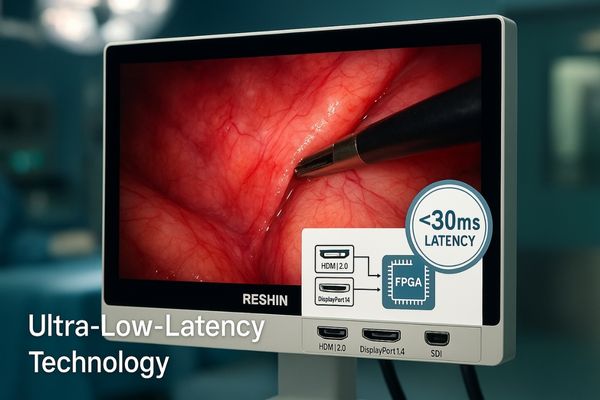
We engineer our surgical monitors from the ground up to minimize latency. Achieving an ultra-low-latency11 signal path is a multi-faceted process. It starts with the choice of interface. We integrate high-bandwidth ports like HDMI 2.0, DisplayPort 1.4, and 12G-SDI, which can handle massive data streams from 4K and 8K sources without needing heavy, delay-inducing compression. Inside the monitor, we utilize powerful, dedicated Field-Programmable Gate Array (FPGA)12 chips and optimized System-on-a-Chip (SoC)13 solutions. These components are programmed with highly efficient, proprietary algorithms designed specifically for rapid video processing. Unlike consumer televisions that may prioritize complex image enhancements at the cost of speed, our processing is streamlined for one purpose: displaying the most accurate image as quickly as possible. This approach allows our monitors, including the large-format MS550P – 55" 4K Surgical Monitor, to achieve a verified latency of well under 30 milliseconds. This ensures that what the surgeon sees is a true real-time representation of the surgical field. We avoid unnecessary processing steps that add delay and focus on delivering a pure, unadulterated signal to the panel, providing the instantaneous feedback that is critical for surgical safety and precision.
Conclusion
Image lag is a critical safety issue in endoscopic surgery, not a minor inconvenience. By understanding its causes and choosing monitors engineered for ultra-low latency, hospitals can protect patients and empower surgeons. To eliminate image lag with real-time surgical display solutions, contact Reshin at martin@reshinmonitors.com.
-
Exploring this resource will provide insights into how minimally invasive techniques enhance surgical outcomes and patient recovery. ↩
-
This resource will delve into advancements in monitor technology that can enhance surgical precision and safety, making it essential for medical professionals. ↩
-
Exploring the CCU’s function can provide insights into how image processing and transmission are optimized in surgical settings. ↩
-
Learning about the effects of 4K video on latency can help in selecting the right equipment for high-resolution surgical procedures. ↩
-
Cognitive load significantly affects surgical outcomes. Discover insights on managing it for better performance. ↩
-
Minimal latency is vital for surgical success. Learn how it enhances precision and reduces errors in surgery. ↩
-
Understanding the effects of image lag can help improve surgical techniques and patient safety. Explore this resource for valuable insights. ↩
-
Discover the advantages of minimally invasive surgery, including reduced recovery time and less risk of complications. This link provides essential information. ↩
-
Understanding total system latency is crucial for ensuring safety and precision in surgeries. Explore this link for detailed insights. ↩
-
Latency issues in 3D endoscopy can lead to disorientation. Learn more about these challenges and solutions in this informative article. ↩
-
Understanding ultra-low-latency can enhance your knowledge of surgical monitor technology and its impact on patient safety. ↩
-
Exploring FPGAs will give you insights into advanced video processing technologies used in high-performance displays. ↩
-
Learning about SoCs can help you understand their significance in enhancing monitor performance and efficiency. ↩

